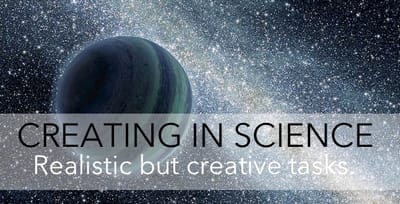
Image from NASA
It’s easy for science instruction to linger in the bowels of Bloom’s Taxonomy as we try to cram everything into the tiny time allotted. However, isolated facts don’t inspire our students.
Let’s set up units that invoke creativity but demand knowledge.
Case Study: The Solar System
When students study the planets, a natural extension is to create a new planet.
However, asking students to create without sufficient knowledge is like putting the cart before the horse. We end up with creations that aren’t grounded in an understanding of science: a planet made of ice, orbiting a foot from the sun, with moons larger than the planet itself.
Creation is the top of Bloom’s Taxonomy for a reason: it’s the most difficult thinking skill and requires the deepest understanding!
Creation has another important characteristic: it’s highly motivating and encourages a deeper understanding than learning isolated facts.
Structured Creation
Lennon and McCartney didn’t write the genre-busting Sgt. Pepper in year one. Their early albums were filled with music that clearly pulled ideas from existing songs.
Likewise, our budding scientists are going to build off existing work.
I love the term remix to explain this process: give students a starting point so they can make “creative modifications” that stay in the realm of realism and reinforce their understand of the content.
1. Motivate Initial Learning
Ever notice how much more you remember from a vacation when you plan it rather than just tag along? That creative involvement leads to a strong attachment to otherwise dull facts.
Motivate students by teasing the final product: we’re creating our own planets! But first, we need to know about the existing solar system so our creations will make scientific sense.
And you better create a planet along with them! Nothing helps creative tasks more than teacher modeling.
2. Teach The Content
Teach the expected content, but as you introduce the facts, emphasize patterns so students can see the realistic range of possibilities:
| Planet| Radius| Moons| Atm | Gravity | Orbit
| —- | —- | —- | —- | —- |
| Mercury| 2,500 km | 0 | He, Na, P | 0.38 g | 87 days
| Earth | 6,300 km| 1| N2, O2| 1 g | 365 days
| Jupiter | 72,000 km | 67 | H2, He | 2.36 g | 43,030 days
| Saturn | 60,000 km | 62 | H2, He | 1.16 g | 10,760 days
| Neptune| 25,000 km| 13| H2, He | 1.14 g | 60,200 days
Naturally, you’d go deeper into each planet, but just from this data, we can see that planets can have a wide range of moons, but even the largest planet’s gravity is no stronger than 2.4 times Earth’s.
This sets up a structure for students’ creativity.
3. Ask Scaffolded Questions
Now, we scaffold towards creation. Start with a question so simple that even the most reluctant creator can participate:
- Is your planet an inner or outer planet?
Simple choices, but they require an understanding of the concepts.
- Which inner or outer planet is yours most similar to?
Since we’ve already narrowed down to the inner or outer planets, students only have four choices. Even kids who claim “I’m not creative” won’t feel intimidated.
- What’s the most significant difference (atmosphere, size, moons)?
Now, we’re dipping our toes into creation, but again it’s scaffolded to focus on one element – and this element reinforces scientific concepts we want them to know about.
- In what way does this difference most strongly affect your planet?
Notice that we’re climbing Bloom’s Taxonomy. Students begin by simply remembering what inner or outer means, now they’re analyzing and evaluating the effects of changes.
Continue asking questions that build in complexity and demand realistic explanation.
If they add 40 moons, ask why this could have happened. They’ll figure out how Jupiter ended up with 67 moons and modify the reasons to fit their own situation.
And remember, you should be creating your own planet. Your think-alouds, explanations, and modeling will go a long way to helping students wrap their minds around this process.
4. Limits on Creativity?
Inevitably, someone will ask: “Can it have way more moons than Jupiter?” or “Can my planet be tiny, but have powerful gravity?”
Tell them:
If you can explain the causes and effects realistically, go for it!
The purpose of the scaffolding is to rein in wild creators and help reluctant students, not to limit students who are already highly creative within the bounds of reality.
5. Products
You probably don’t need my help to see the amazing products creation leads to. It’s open house paradise!
6. Extensions
There’s always a student who falls in love with his creation and goes further than expected. A couple ideas for extending planet-creation:
-
Research who discovered each of the planets. Create a scientist who discovered your planet.
-
Let’s leave the solar system and examine:
- Other types of terrestrial planets, including the “diamond planet!”
- The five types of gas giants.
- Rogue planets: planets without a star!
- Super Earths: huge earth-like planets.
Other Content
Scaffolded creation isn’t limited to planets! Imagine:
- biomes based on deserts, tundras, or rain forests
- life-cycles based on mice, butterflies, or frogs
- a new region of the electromagnetic spectrum similar to x-rays, gamma rays, or radio waves
- a species of dinosaur based on the Triceratops
- a new type of igneous rock
And you certainly don’t need to stay in science. Imagine your students extending social studies content as well:
- a newly discovered ancient civilization
- a previously unknown Native American tribe
- a group of colonies that rebels to form a new country
Thoughtfully scaffold your questions, encourage bold creativity, and soon you’ll have even the most hesitant student creating!
